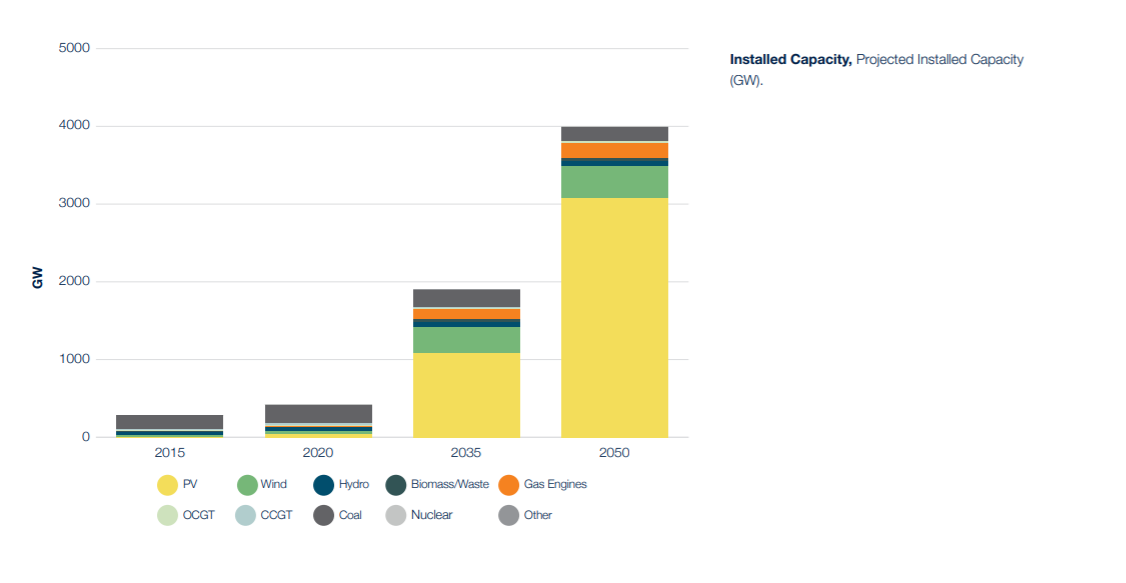From pv magazine India
India could cut its overall cost of electricity in half and reach net zero before 2050 by developing a 100% renewable energy power system, according to a power system modeling study by Wärtsilä and the Finnish Lappeenranta-Lahti University of Technology.
The modeling shows that increasing the share of renewable energy in the overall installed power capacity from 25% today to 100% by 2050 could cut the cost of meeting electricity demand by 48%, from INR 6,000 ($81)/MWh in 2020 to INR 3,120/MWh in 2050. This cost, also referred to as overall system cost, includes the levelized cost of electricity generation, the cost of energy storage, transmission interconnections, and the costs of curtailing surplus renewable generation.
Renewables, when paired with flexible generation technologies (thermal balancing power plants and energy storage), can improve the affordability of electricity while ensuring the reliability of system operations, according to the study.
Power demand in India is expected to increase to 5,921 TWh (with 1,023 GW of peak demand), up 340% from 1,345 TWh in 2020. The modeling confirms that India can affordably meet this increased load through renewable energy, aided by low-cost solar.
However, the study states the total system capacity must be scaled up to an unprecedented degree to serve this increased load through mid-day peaks and to charge energy storage resources such as batteries to offset intermittent renewable energy generation. It projects that 4,000 GW of installed capacity is needed for a 100% renewable system, a 10-fold increase in the overall power capacity in 2020. Solar would make up 76% (3,076 GW) of this total installed capacity by 2050. This would also be supported by a total wind capacity of around 410 GW by 2050, combined with hydro and carbon-neutral gas.
Popular content
To achieve the projected solar share, new PV installations must rise by 885%, from 7 GW a year today, to 69 GW a year by 2035, rising to 79 GW a year between 2035 and 2050, according to the study.
Wärtsilä’s modeling shows that flexibility through energy storage is key to achieving the cost-optimal renewable baseload system – to shift generation when it is surplus, during the day, to times when renewables are not available, during evening or the night. Thermal balancing power plants, backed by battery energy storage, must also be deployed to manage sudden surges in demand or drops in renewable generation.
The modeling shows that India would need about 99 TWh of storage capacity and a total of 187 GW of fast-start load-following gas engines by 2050 to provide rapid grid balancing. Storage capacity includes storage in the form of both batteries and gas storage, mainly in the form of sustainable fuels (green hydrogen, and methane, for example). Together, these technologies could form the backbone of a reliable, cost-optimal power system for India.
“Increasing renewable energy could also generate major new revenues from hydrogen production, creating a technology market worth $39.8 billion,” said Wärtsilä and the Finnish Lappeenranta-Lahti University of Technology.
This content is protected by copyright and may not be reused. If you want to cooperate with us and would like to reuse some of our content, please contact: editors@pv-magazine.com.



Something that may happen in 2050 is 100% dependent that things that MUST happen by 2030 happen. Silly to talk about 2050 – focus on the short term or there will NOT be a long term
Excellent analysis, showing how #SolarBoom will actually make $$ as we #EndFossil. This is even clearer right Now as fossil fuels are literally 50%+ higher cost than just 1 year ago — #Fossil is a highly Cost Unstable Energy Source that we Cannot Afford to Continue Using without repeated disruptions to our collective GDP’s.
But the pace of Solar PV required for this energy system transition is challenging. That is why we believe Extremely Fast Automated Assembly and Installation of Solar is necessary. Once we get past the current jobs challenge due to COVID, then we will again see the value of bringing Automation and Robotics to Utility-Scale Solar Installation.